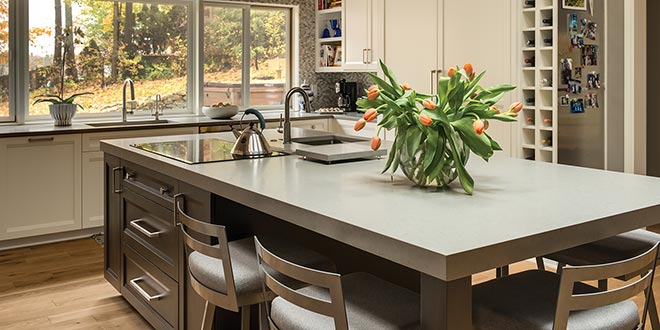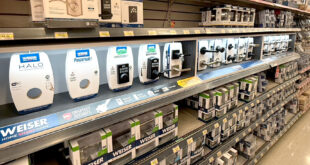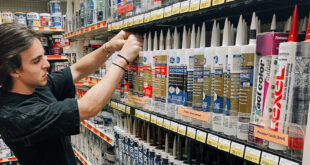To view a PDF of this story, click here.
By Renee Changnon, rchangnon@nrha.org
Sink In To Plumbing
Designers Talk About What’s New in Decorative Plumbing
“When a client is ready to update their bathroom, the first thing I want them to select is a new, upgraded toilet that not only functions well, but looks great, too,” says Ebony Stephenson, owner of Designs by Ebony in Newport News, Virginia.
While the toilet may not seem like a very trendy product, Stephenson insists this necessary piece can make or break a bathroom’s design.
But it’s not always a commonly discussed product. And how many of your employees can talk passionately about toilets, faucets, sinks or showers?
Beyond the pipes, plumbing is a fashion-forward category, so you need to bring in the latest products trending in your area to encourage customers to turn to your business.
Whether you have a small space devoted to decorative plumbing or an entire showroom to feature the category, it’s important to pay attention to design trends so you can be the category leader in your market.
Hardware Retailing spoke to design professionals from across the country, including Stephenson, to find out the latest trends in decorative plumbing.
In this article, three designers share what trends consumers across the country are looking for today. We’ll also offer some suggestions of how you can best showcase decorative plumbing products and trends through a working on-site showroom or through an online portfolio. Be sure to read all nine showroom tips and tricks, which can help you keep customers interested.
Designer Insights
For a closer look at decorative plumbing trends, Hardware Retailing spoke with three designers who have expertise in the category. Because their businesses are located in different parts off the country, they each see varied kinds of trends. Their insights can lead you toward what customers may like, but they agree it’s vital to listen to customers first.

Kitchen Trends
Many homeowners treat the kitchen as the heart of the home. They want to make their cooking spaces functional, attractive places to gather with friends and family.
Decorative plumbing is found throughout the kitchen. Whether the room has a unique faucet that matches the cabinet hardware or a secondary sink on an island to allow multiple chefs to work at once, there are many trends gaining traction, while others are becoming less and less popular.
Adam Gibson of Adam Gibson Design in Carmel, Indiana, notes that apron sinks, also known as farmhouse sinks, are increasingly popular among his clients.
The traditional farmhouse sink is a lot deeper than modern stainless steel undermount or top-mount sinks. Because it’s installed under the countertop, it’s easy to wipe water or crumbs into the sink. Farmhouse sinks are frequently made of fireclay, which is a material manufactured from clay at a high temperature, which makes it resistant to scratches, staining and chipping. Porcelain is also a common material in this type of sink, and now there are more options available in stainless steel and copper.
Stephenson says about half of her clients prefer sinks that are split into two equal bowls, and the other half opt for one big open sink bowl.
“In the kitchen, homeowners used to just go with anything, but now they want the sink to be a showcase and a statement piece in the room,” Stephenson says. “Customers are having more fun with sinks.”
Alana Busse, lead designer at Westside Remodeling in Thousand Oaks, California, says her clients tend to prefer undermount sinks as the standard in the kitchen. Popular finishes include stainless steel, composite granite, fireclay, copper, quartz, natural stone and cast iron. These are often chosen based on the aesthetic of the design and other materials found throughout the kitchen.
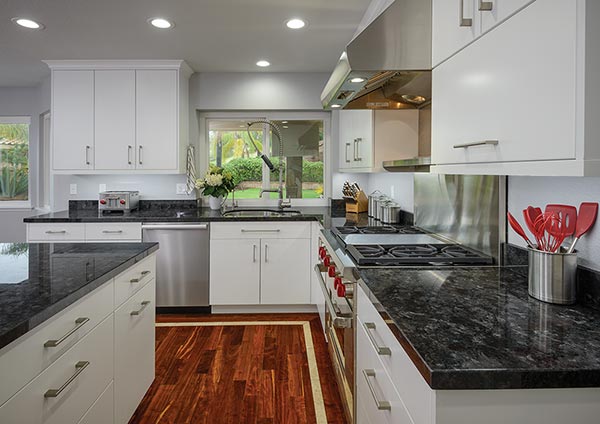
“We’re seeing a lot of one-bowl sinks in the kitchen, rather than the two-bowl. With one deep-bowl sink, you are less likely to spill on the floor,” Busse says. “Plus, in this very pet-friendly community, single bowl sinks provide a way for pet owners to bathe a small or medium-sized dog.”
One trend all three designers see exiting the scene is the pot filler faucet, which is a swing-out faucet on a long, jointed arm mounted over a homeowner’s stove. These have been in restaurants for many years, but really made an entrance into the consumer market a few years ago. However, secondary sinks are taking the place of the pot filler in popularity.
“Honestly, we don’t see many pot fillers anymore,” Busse says. “Instead, we see prep sinks coming into play. For someone with an island, they might have a secondary sink available, which works great if two people are cooking at the same time.”
As a designer who is also certified in aging in place, which provides design modifications that allow older individuals to live in their own homes safely as they age, Stephenson says pot fillers could pose a hazard, especially for an elderly person filling up a pot and then trying to move that heavy pot of boiling water to drain it.
Another growing trend is touchless faucets, since the technology has improved among manufacturers. With touchless faucets, the user can wave his or her hand under a sensor to turn the water on and off. Improvements to this technology also allow functions like pausing the flow of water. Touchless technology has been in commercial settings for years, but has recently been making more of a splash in homes.
For Busse, the faucet, whether it contains touchless technology or not, is something she encourages her clients to invest a bit more in
to ensure it will last the wear and tear of everyday use.

“The faucet is one thing you use the most. I always suggest a product that can last, since it’s the workhorse of the kitchen,” Busse says.
An easy addition to the kitchen is incorporating decorative strainers in sink drains, Stephenson says. People can pick something that matches the decor or theme of the space to help keep food scraps out of the sink in an attractive way.
Decorative sink stoppers can be made of stainless steel and other materials, featuring unique patterns like a snowflake for wintertime or a starfish for a beach-themed home.
To avoid getting their backsplash dirty, Busse says her clients have been opting for an air button drilled into the countertop to control the garbage disposal rather than having a switch on the wall.
As for finishes, brushed nickel, satin nickel, chrome, oil-rubbed bronze and gold are all common choices.
Stephenson says another finish that’s becoming increasingly popular is a champagne bronze color, which has lighter gold tones and a brass gold finish, making it more subtle than brass on its own.
In the kitchen, there are even innovations with finishes that eliminate the possibility of smudges with spot-resistant finishes keeping the look of rooms clean and tidy.
Overall, consumers want finishes incorporated into their plumbing that provide durability and feature a more transitional style, which combines traditional and contemporary styles and is less likely to look dated.
Bathroom Trends
Whether they are eager to escape the stress in an in-home spa environment or are simply getting ready for a day at the office, homeowners like master bathrooms and powder rooms with decorative plumbing that adds a creative flare.
According to Busse, the shower is the key design element of the bathroom. Rather than installing the combination shower and bathtub, many homeowners prefer a large open shower, she says.
“In California, people want what I call the human car wash,” Busse says. “They want the hand wand, the overhead rain showerhead and then two wall-mounted his-and-hers showerheads. They want as much water as they can legally get.”
Among Stephenson’s customers, the preference is a two-person shower and a freestanding soaking bathtub—without jetted technology.
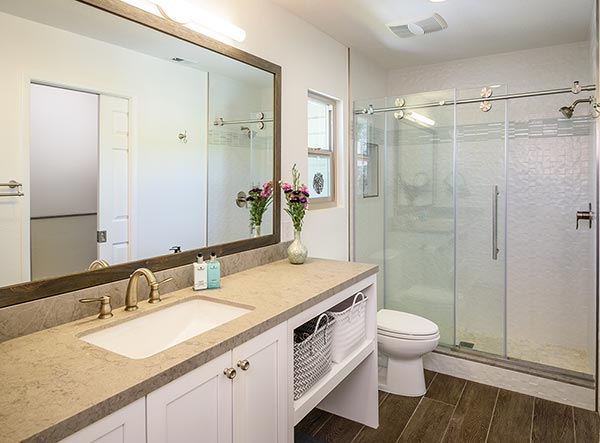
“In Virginia, everything in the bathroom design is focused more on being sleek and clean,” Stephenson says. “Also, more people are looking to incorporate aging in place design concepts to this space, so they’ll have a walk-in shower and grab bars included to prepare for the future.”
Many showers have at least two showerheads, and handheld body sprays are secondary features.
Inside the shower, decorative shower drains are another way to make the shower look polished.
“We’re seeing more and more decorative shower drains,” Busse says. “Often they are square-shaped shower drains with unique patterns. The old round shower drains are not as common. If someone is spending a good amount to improve the bathroom, they want a nice drain.”
Showers often feature glass floor-to-ceiling walls with an opening instead of a door. Options like shower corner splashguards help prevent water from escaping. Removing the door provides a sleek look, and cuts costs on a glass door.
Although the pedestal and wall-mounted sinks have been popular in the past, Busse’s customers prefer to have a sink within cabinetry.
On the East Coast, Stephenson says her customers prefer undermount sinks, and square-shaped sinks are in, while oval and round-shaped sinks are out.
While toilets may not seem like a trendy part of the bathroom, Stephenson says a cheap, insignificant toilet can ruin a fully redone bathroom.
“As a designer, it hurts my heart to see a beautiful bathroom with an average toilet,” Stephenson says. “They will use their toilet every day, so I want it to be something they like.”
Toilet trends she sees include a preference for comfort-height elongated toilets, which are higher off the ground, as well as compact elongated toilets for small powder rooms. Technology is also improving the bathroom experience, with soft-close toilet seats, as well as night-lights and air fresheners built into the toilet.
“You can invest in toilets that have all the bells and whistles,” Stephenson says. “Instead of flushing, the client can use an LED touchscreen on the wall to flush it. When you walk to the toilet, the seat opens for you and it can even heat up.”
Technological advancements are incorporated in the toilet as well, like remote controls. Users can flush the toilet or close, open or heat the seat, all with the touch of a button. However, many customers may not be as likely to invest in these extras, as they may fear the advancements will change shortly after installation.
Other Trends Throughout the Home
Decorative plumbing trends are also featured in other areas of the home, like a laundry room, the garage or an in-home bar.
While some still prefer the basics, more consumers are looking to create to a nicer laundry room, straying from the white acrylic sink and going for full cabinetry and large undermount sinks, and using remnants of another countertop project, like quartz or granite from the kitchen.
For those with a large enough laundry room, they’ll add a deep sink with a pullout faucet they can use to easily rinse clothes or eliminate stains before throwing a load in the washing machine.
Gibson says his clients often opt for the basics in the garage. If he’s designing these spaces, there might be a stainless steel sink with a plain pullout faucet.
Adding a faucet in the garage is another great way to help keep the rest of the home clean, Busse says. “If a client works on cars or motorcycles, they’re likely going to get dirty. We add sinks to the garage often, as it allows customers to get cleaned up, or to clean off their garden tools after spending some time working in the yard.”
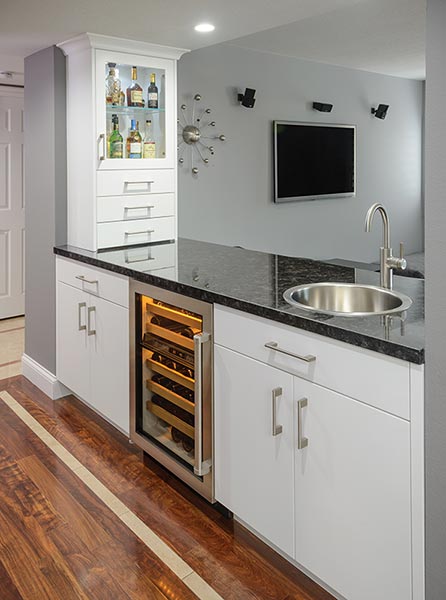
Designing a bar is one way to get creative with decorative plumbing and to showcase new ideas. Homeowners can have a little more fun with sink shapes and faucets because they’re paying more attention to looks than functionality in this space.
Stephenson says her customers tend to be more confident and creative by incorporating statement faucets and sinks in a bar area.
“My clients are thinking outside the box,” Stephenson says. “They’re looking for different shapes and materials, which helps make the bar sink a focal point of the space.
9 Showroom Tips and Tricks
- Refresh the Space
As a designer who has previously worked within showrooms, Stephenson says it’s important to keep the showroom updated every couple of months. Highlight trends that are popular in your area. If you are ready to swap something out, you can sell the showroom model at a discount. - Organization is Key
As the lead designer who utilizes the showroom when working with clients and helping them pick out pieces, Busse says the most important thing is to stay organized and know where everything is located. That way, you can easily show your customers what you have on display and highlight products you can order. - Ask Questions
To best assist a customer who is looking to update a kitchen, bathroom or another space, it is vital to ask them questions, Busse says. While consumers may have done plenty of online research, your job is to help break a project down and walk through it with your customers, step by step. - Out With the Old, In With the New
Another tip from Busse is to eliminate products that are discontinued immediately. This ensures you won’t upset a customer who falls in love with a showroom model, only to discover they can’t purchase it. However, you could sell the model and any other discontinued inventory at a lower price. - Have Samples on Hand
Stephenson says another way to give customers a better idea of the products on hand is by having samples that they can touch and feel. Samples on the wall are nice to see on display, but having something on a ring or that can be moved around is even better. - Stay Up to Date on Trends
Since trends are always changing, it’s important for a retailer to stay aware of the latest trends and incorporate them into the showroom. “Look at your sales,” Stephenson says. “What are designers and homeowners purchasing? While magazines and blogs are great places to look, it’s important to just listen to what people are asking for.” - Add Working Displays
Another suggestion Stephenson recommends is adding working displays to the showroom if space allows. While this may require a bit more work on the retailer’s part as far as gaining extra permits and plumbing, working displays may make the money back in additional sales, she says. - Create an Online Showroom
If a showroom is not a possibility, there are still ways to showcase decorative plumbing and other products available for your customers, Gibson says. He recommends using a website or creating a presence on Houzz.com. Take photos of products in use and share with your customers. - Get Involved
For Busse, being involved in home improvement organizations is a great way to stay aware of trends and network with others. She is the National Kitchen and Bath Association (NKBA) Central Coast and Valleys Chapter President, where she runs meetings and events with others in the industry.
 Hardware Retailing The Industry's Source for Insights and Information
Hardware Retailing The Industry's Source for Insights and Information



